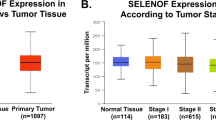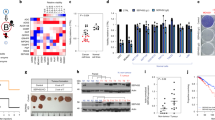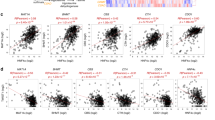Abstract
The micronutrient element selenium (Se) has been shown to be effective in reducing the incidence of cancer in animal models and human clinical trials. Selenoproteins and low molecular weight Se compounds were implicated in the chemopreventive effect, but specific mechanisms are not clear. We examined the role of Se and selenoproteins in liver tumor formation in TGFα/c-Myc transgenic mice, which are characterized by disrupted redox homeostasis and develop liver cancer by 6 months of age. In these mice, both Se deficiency and high levels of Se compounds suppressed hepatocarcinogenesis. In addition, both treatments induced expression of detoxification genes, increased apoptosis and inhibited cell proliferation. Within low-to-optimal levels of dietary Se, tumor formation correlated with expression of most selenoproteins. These data suggest that changes in selenoprotein expression may either suppress or promote tumorigenesis depending on cell type and genotype. Since dietary Se may have opposing effects on cancer, it is important to identify the subjects who will benefit from Se supplementation as well as those who will not.
This is a preview of subscription content, access via your institution
Access options
Subscribe to this journal
Receive 50 print issues and online access
$259.00 per year
only $5.18 per issue
Buy this article
- Purchase on Springer Link
- Instant access to full article PDF
Prices may be subject to local taxes which are calculated during checkout



Similar content being viewed by others
Abbreviations
- GPx1:
-
glutathione peroxidase 1
- HCC:
-
hepatocellular carcinoma
- Se:
-
selenium
- SelR:
-
selenoprotein R
- Sep15:
-
15 kDa selenoprotein
- TGFα:
-
transforming growth factor α
- TPS:
-
triphenylselenonium chloride
- TR1:
-
thioredoxin reductase 1 (cytosolic enzyme* also called TxnRd1 and TrxR1)
- TR3:
-
thioredoxin reductase 3 (mitochondrial enzyme* also called TxnRd2 and TrxR2)
References
Arner ES and Holmgren A . (2000). Eur. J. Biochem., 267, 6102–6109.
Bock A . (2000). Biofactors, 11, 77–78.
Burk RF . (2002). Nutr. Clin. Care, 5, 75–79.
Burk RF and Lane JM . (1983). Fundam. Appl. Toxicol., 3, 218–221.
Calvisi DF, Factor VM, Ladu S, Conner EA and Thorgeirsson SS . (2004). Gastroenterology, 126, 1374–1386.
Carlson BA, Novoselov SV, Kumaraswamy E, Lee BJ, Anver MR, Gladyshev VN and Hatfield DL . (2004). J. Biol. Chem., 279, 8011–8017.
Clark LC, Combs GF, Turnbull BW, Slate EH, Chalker DK, Chow J, Davis LS, Glover RA, Graham GF, Gross EG, Krongrad A, Lesher Jr JL, Park HK, Sanders Jr BB, Smith CL and Taylor JR . (1996). J. Am. Med. Assoc., 276, 1957–1963.
Driscoll DM and Copeland PR . (2003). Annu. Rev. Nutr., 23, 17–40.
El-Bayoumy K and Sinha R . (2004). Mutat. Res., 551, 181–197.
Factor VM, Kiss A, Woitach JT, Wirth PJ and Thorgeirsson SS . (1998). J. Biol. Chem., 273, 15846–15853.
Factor VM, Laskowska D, Jensen MR, Woitach JT, Popescu NC and Thorgeirsson SS . (2000). Proc. Natl. Acad. Sci. USA, 97, 2196–2201.
Felix K, Gerstmeier S, Kyriakopoulos A, Howard OM, Dong HF, Eckhaus M, Behne D, Bornkamm GW and Janz S . (2004). Cancer Res., 64, 2910–2917.
Fu Y, Sies H and Lei XG . (2001). J. Biol. Chem., 276, 43004–43009.
Ganther HE . (1999). Carcinogenesis, 20, 1657–1666.
Gladyshev VN, Factor VM, Housseau F and Hatfield DL . (1998). Biochem. Biophys. Res. Commun., 251, 488–493.
Gouaze V, Andrieu-Abadie N, Cuvillier O, Malagarie-Cazenave S, Frisach MF, Mirault ME and Levade T . (2002). J. Biol. Chem., 277, 42867–42874.
Hatfield DL (ed) (2001). Selenium: Its Molecular Biology and Role in Human Health. Kluwer Academic Publishers: Norwell, MA.
Hill KE and Burk RF . (1984). Toxicol. Appl. Pharmacol., 72, 32–39.
Hironaka K, Factor VM, Calvisi DF, Conner EA and Thorgeirsson SS . (2003). Lab. Invest., 83, 643–654.
Ip C, Dong Y and Ganther HE . (2002). Cancer Metastasis Rev., 21, 281–289.
Ip C, Thompson HJ and Ganther HE . (1998). Anticancer Res., 18, 9–12.
Kim HY and Gladyshev VN . (2004). Mol. Biol. Cell, 15, 1055–1064.
Klein EA, Thompson IM, Lippman SM, Goodman PJ, Albanes D, Taylor PR and Coltman C . (2000). Prostate Cancer Prostatic Dis., 3, 145–151.
Kryukov GV, Castellano S, Novoselov SV, Lobanov AV, Zehtab O, Guigo R and Gladyshev VN . (2003). Science, 300, 1439–1443.
Low SC and Berry MJ . (1996). Trends Biochem. Sci., 21, 203–208.
Milner JA, McDonald SS, Anderson DE and Greenwald P . (2001). Nutr. Cancer, 41, 1–16.
Moustafa ME, Carlson BA, El-Saadani MA, Kryukov GV, Sun QA, Harney JW, Hill KE, Combs GF, Feigenbaum L, Mansur DB, Burk RF, Berry MJ, Diamond AM, Lee BJ, Gladyshev VN and Hatfield DL . (2001). tRNA. Mol. Cell. Biol., 21, 3840–3852.
Rayman MP . (2000). Lancet, 356, 233–241.
Reiter R and Wendel A . (1984). Biochem. Pharmacol., 33, 1923–1928.
Santoni-Rugiu E, Nagy P, Jensen MR, Factor VM and Thorgeirsson SS . (1996). Am. J. Pathol., 149, 407–428.
Stadtman TC . (1996). Ann. Rev. Biochem., 65, 83–100.
Sunde RA . (1994). Selenium in Biology and Human Health. RF Burk (ed). Springer-Verlag: New York, pp 45–59.
Whanger PD . (2004). Br. J. Nutr., 91, 11–28.
Yoshizawa K, Willett WC, Morris SJ, Stampfer MJ, Spiegelman D, Rimm EB and Giovannucci E . (1998). J. Natl. Cancer Inst., 90, 1219–1224.
Yu SY, Zhu YJ and Li WG . (1997). Biol. Trace Elements Res., 56, 117–124.
Zhao H, Whitfield ML, Xu T, Botstein D and Brooks JD . (2004). Mol. Biol. Cell., 15, 506–519.
Acknowledgements
Services of the University of Nebraska-Lincoln genomics facility, headed by Dr Yuannan Xia and the bioinformatics facility, headed by Dr Guoqing Lu, are acknowledged. We thank Dr Ian Mason for providing hydroxysteroid dehydrogenase antibodies and Dr Hwa-Young Kim for help with methionine sulfoxide reductase assays. Supported by NIH CA080946 and in part by GM061603 and AG021518 (to VNG).
Author information
Authors and Affiliations
Electronic supplementary material
Rights and permissions
About this article
Cite this article
Novoselov, S., Calvisi, D., Labunskyy, V. et al. Selenoprotein deficiency and high levels of selenium compounds can effectively inhibit hepatocarcinogenesis in transgenic mice. Oncogene 24, 8003–8011 (2005). https://doi.org/10.1038/sj.onc.1208940
Received:
Revised:
Accepted:
Published:
Issue Date:
DOI: https://doi.org/10.1038/sj.onc.1208940
Keywords
This article is cited by
-
Environmental Selenium and Human Health: an Update
Current Environmental Health Reports (2018)
-
Effects of Selenium Supplementation on the Diabetic Condition Depend on the Baseline Selenium Status in KKAy Mice
Biological Trace Element Research (2018)
-
Proteome mapping of epidermal growth factor induced hepatocellular carcinomas identifies novel cell metabolism targets and mitogen activated protein kinase signalling events
BMC Genomics (2015)
-
Selenoprotein Genes Exhibit Differential Expression Patterns Between Hepatoma HepG2 and Normal Hepatocytes LO2 Cell Lines
Biological Trace Element Research (2015)
-
Effect of Diethylcarbamazine Citrate and Setaria equina Excretory–Secretory Material on Rat Hepatocellular Carcinoma
Archivum Immunologiae et Therapiae Experimentalis (2014)



